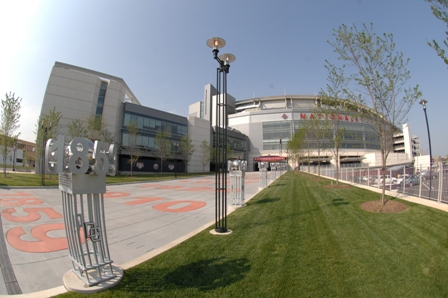Raking the dirt between second and third base, Larry DiVito, head groundskeeper for the Washington Nationals, pauses to take in his surroundings. In a few hours, the ballpark’s nearly 42,000 seats will be filled with a sea of red and white, as cheers of “Go Nats!” rain down.
Nationals Park has given the team and their fans something they’ve wanted since the team returned to Washington, D.C. in 2005—a place to call home.
Before this season, the Nationals played at Robert Fitzgerald Kennedy (RFK) Stadium, home of the Washington Redskins from 1961 until 1996. While RFK served its purpose as an interim home, both the organization and their fans eagerly awaited the new park.
The same can be said for DiVito himself. A graduate of San Francisco State University, DiVito first broke into the turf industry in 1995 after several years as a high school baseball coach. He then became the head groundkeeper for the Triple-A team for Major League Baseball’s Boston Red Sox. DiVito remained with the Pawtucket Red Sox until 2001 when he was hired by the Los Angeles Dodgers as their ground crew manager.
“I was the number two guy for the Dodgers, so I basically ran the crews and maintained the fields,” says DiVito. “It was a great opportunity and I gained a lot of valuable experience that I’ve been able to apply during my time with the Nationals.”
In 2006, DiVito returned east, joining the Washington Nationals. The team had announced plans to build a new ballpark, but for the time being DiVito’s attention was on RFK, where he and his crew maintained turf for Major League Soccer’s D.C. United and the Nationals.
“With both D.C. United and the Nationals using the facility, there was a lot of wear on the bermudagrass turf,” explains DiVito. “There was also excess shade on the turf due to the stadium design, which made life difficult at times.”
Following two years at RFK, DiVito and his crew were as eager as the rest of the organization and its fans for the opening of Nationals Park.
Situated in the thriving Capitol Riverfront section with a view of the nation’s capitol and the Washington Monument, Nationals Park has been worth the wait. “Fans have embraced the new ballpark and we couldn’t be happier,” DiVito says. “From the front office to our ticket takers, everyone feels the excitement around here.”
On March 30, 2008, the first pitch was thrown out by President George W. Bush as the Nationals went on to win their home opener, 3-2 against the division rival Atlanta Braves. “Starting with a win in the new park, this place was electric,” recalls DiVito.
Unlike the bermudagrass of RFK, the field at Nationals Park is a three-way blend of three varieties of Kentucky bluegrass: Princeton 105, Brilliant and Midnight Star. The turf’s rootzone is 93 percent sand and seven percent soil. “The bluegrass blend is ideal for its durability and density, ensuring the players will have stable footing in the field,” explains DiVito.
In addition to the sights and activities offered, there is an attraction unique to Nationals Park synonymous with the Capital Region itself—cherry trees. Adorning the entrance ways and the left field bleachers, Nationals Park is the first Major League Baseball ballpark to have the signature Washington D.C. tree on site. “There are 35 cherry trees planted in all, with 16 planted in left field and 19 along the entry ways,” says DeVito.
But the cherry trees could potentially cause headaches for DiVito and his crew. Young saplings are susceptible to diseases and insect pests, such as black cherry aphids. Measuring little more than three millimeters in length as adults, aphids cause significant damage in high populations. Adult and nymph aphids suck the sap out of the leaves, resulting in curled leaves and distorted stems.
When Bayer Environmental Science learned of the team’s plans to plant cherry trees at the new park, it offered to work with the team to control black cherry aphids. Bayer’s CoreTect product is designed to prevent insect infestation and ensure tree health.
DiVito’s assistant, John Royse, applied a 2.5 gram tablet to the base of each tree. The controlled-release properties of CoreTect provide insect control throughout the year and allow plants to better survive harsh environmental conditions, including drought, heat and poor soils.
CoreTect tablets systemically trigger enzymatic pathways that promote more efficient use of energy, nutrients and water, facilitating stress-mediation. More efficient utilization of energy allows plants to both combat stress and promote root and shoot growth.
“The cherry trees are a fan favorite and we want to make sure they thrive and are enjoyed for years to come,” explains Royse. “CoreTect provides us the protection and control we need to make that happen.”
Tim Londergan is an account executive the The Tierney Agency, Philadelphia, PA.


